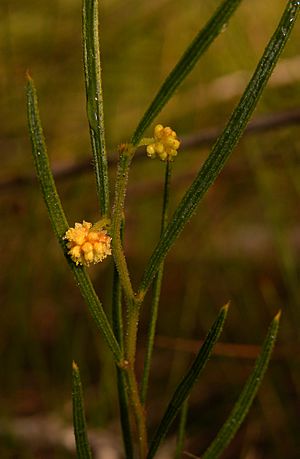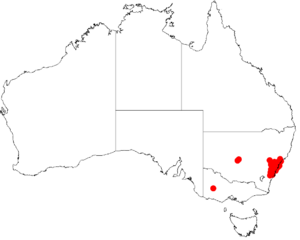Tiny wattle facts for kids
Quick facts for kids Tiny wattle |
|
|---|---|
 |
|
| Conservation status | |
| Scientific classification | |
| Genus: |
Acacia
|
| Species: |
bynoeana
|
 |
|
| Occurrence data from AVH | |
| Synonyms | |
|
Acacia pumila Maiden & R.T.Baker Racosperma bynoeanum (Benth.) Leslie Pedley |
|
The Acacia bynoeana, often called the Tiny Wattle or Bynoe's Wattle, is a special type of plant. It belongs to the Acacia family. This plant grows naturally in eastern Australia. It is a small shrub that needs protection. In New South Wales, it is listed as endangered. It is also considered vulnerable under a big Australian law. This law is called the Environment Protection and Biodiversity Conservation Act 1999. This means the Tiny Wattle is at risk and needs help to survive.
Contents
What the Tiny Wattle Looks Like
This small shrub usually grows to about 0.5 meters (about 1.6 feet) tall. It has a "decumbent" habit, which means it grows low to the ground. Its branches are round and hairy. They have tiny, pointed leaf-like parts called stipules, about 1.5 mm long.
Like most Acacias, the Tiny Wattle does not have true leaves. Instead, it has "phyllodes." These are flattened stems that look and act like leaves. The phyllodes are narrow and can be straight or slightly curved. They are usually 1 to 6 cm long and 1 to 3 mm wide. When they are young, they are hairy. But as they get older, they become smooth and hairless.
Flowers and Seed Pods
The Tiny Wattle usually blooms in the summer. This happens between December and March. It produces small, round flower-heads. These flower-heads are about 3 to 4 mm across. Each one contains 10 to 25 bright golden flowers.
After the flowers bloom, firm, papery seed pods grow. These pods are straight and have bumps where the seeds are inside. The pods are 1 to 3 cm long and 3 to 4 mm wide.
How the Tiny Wattle Got Its Name
The Tiny Wattle was first officially described in 1855. A botanist named George Bentham gave it its scientific name. This happened in a scientific paper called Plantae Muellerianae: Mimoseae.
Later, in 2003, another botanist named Leslie Pedley reclassified it. He called it Racosperma bynoeanum. But in 2006, it was moved back to the Acacia group. Another old name for this plant is Acacia pumila.
The plant's specific name, bynoeana, honors a person. It is named after Benjamin Bynoe. He was a surgeon in the Royal Navy. He collected the first sample of this plant. This sample helped scientists identify and name the species.
Where the Tiny Wattle Grows
The Tiny Wattle is found in New South Wales, Australia. Most of these plants grow in areas from Morisett in the north. They extend down to Berrima and the Illawarra region. You can also find them west towards the Blue Mountains. There is another group of these plants in the Hunter Valley and Morton National Park.
This shrub grows best in sandy soils. It is often found in "heathland" areas. These are open areas with low-growing shrubs. It also grows in "dry sclerophyll forest" communities. These are forests with tough, dry leaves that can handle dry conditions.


